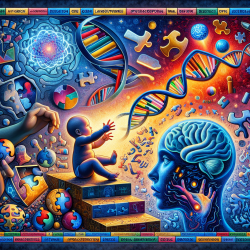Introduction
In the realm of autism spectrum disorders (ASD), understanding the variability in early language development is crucial. A recent study titled Large-scale associations between the leukocyte transcriptome and BOLD responses to speech differ in autism early language outcome subtypes explores the biological underpinnings of this variability. This research uncovers significant associations between gene expression in blood leukocytes and neural responses to speech, as measured by functional magnetic resonance imaging (fMRI), in toddlers with ASD.
Key Findings
The study identifies distinct gene co-expression modules in blood leukocytes that correlate with neural responses to speech in toddlers with ASD. These modules differ significantly between toddlers with poor and good early language outcomes, as well as typically developing toddlers. This suggests that early language outcomes in ASD are linked to unique biological processes, which can be detected through blood samples and neuroimaging.
Implications for Practitioners
For practitioners, these findings highlight the potential of using gene expression data from blood samples as a non-invasive method to gain insights into the neural mechanisms underlying language development in ASD. This approach could enhance the precision of early diagnosis and intervention strategies, tailoring them to the specific biological profiles of children with ASD.
Encouraging Further Research
While the study provides a promising direction, it also opens avenues for further research. Practitioners and researchers are encouraged to explore how these findings can be integrated into clinical practice, potentially leading to more personalized and effective interventions for children with ASD.
Conclusion
The study underscores the importance of considering biological diversity in ASD when assessing early language outcomes. By leveraging gene expression data and neuroimaging, we can move towards more precise and individualized approaches in autism therapy.
To read the original research paper, please follow this link: Large-scale associations between the leukocyte transcriptome and BOLD responses to speech differ in autism early language outcome subtypes.










